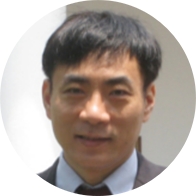

Analytical and computational approaches to explore the effect of equilibrium and nonequilibrium fluctuations on the stability of ordered structures in various physical and biophysical contexts; collective behavior and pattern formation in biological systems.
Dr. Lei-Han Tang, Professor and Director of Institute of Computational and Theoretical Studies, Hong Kong Baptist University. Dr. Tang completed his PhD in statistical physics at the Carnegie Mellon University in 1987. He did postdoctoral work on nonequilibrium and disordered systems at various US and German institutions and served as a Lecturer at the Imperial College London, before joining the Hong Kong Baptist University in 1997 as an associate professor and then full professor. In 2010, he was appointed Chair Professor and Head of Complex Systems Division, Beijing Computational Science Research Center. His research combines analytical and computational approaches to explore the effects of equilibrium and nonequilibrium fluctuations in various physical and biophysical contexts. In recent years, he has collaborated with experimentalists on the development of quantitative tools and models to analyze and integrate biological data and behavior at the cellular level, in particular those related to metabolism, cell motility, and development. He has been an active researcher and facilitator of interdisciplinary study of living systems. He was elected Fellow of the American Physical Society in 2010 and is a current member of the IUPAP C3 Commission on Statistical Physics.
Tel: (852) 3411-7031
EMAIL: lhtang@csrc.ac.cn/lhtang@hkbu.edu.hk
WEBSITE: https://www.csrc.ac.cn/en/people/faculty/35.html/ http://physics.hkbu.edu.hk/home/info.php/people_details/pID,16
Publications/Patents (recent)
S.-W. Wang and L.-H. Tang, “Emergence of collective oscillations in adaptive cells”, Nature Communications 10, 5613 (2019).
Y. Wang, J.-H. Park, C. S. Lupala, J.-H. Yun, Z. Jin, L. Huang, X. Li, L. Tang, W. Lee and H. Liu, “Computer aided protein engineering to enhance the thermo-stability of CXCR1- T4 lysozyme complex”, Scientific Reports 9, 5317 (2019).
S.-W. Wang, K. Kawaguchi, S.-i. Sasa, and L.-H. Tang, “Entropy production of nanosystems with time scale separation”, Phys Rev Lett 117, 070601 (2016).
Y. Shen, T. Fatemeh, L. Tang, Z. Cai, “Quantitative metabolic network profiling of Escherichia coli: An overview of analytical methods for measurement of intracellular metabolites”, Trends in Analytical Chemistry 75, 141-150 (2016).
C. Liu, X. Fu, L. Liu, X. Ren, C.K.L. Chau, S. Li, L. Xiang, H. Zeng, G. Chen, L.-H. Tang, P. Lenz, X. Cui, W. Huang, T. Hwa, J.-D. Huang, “Sequential establishment of stripe patterns in an expanding cell population”, Science 334, 238 (2011).